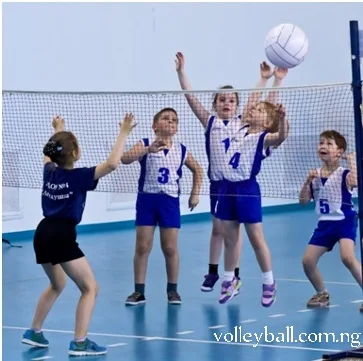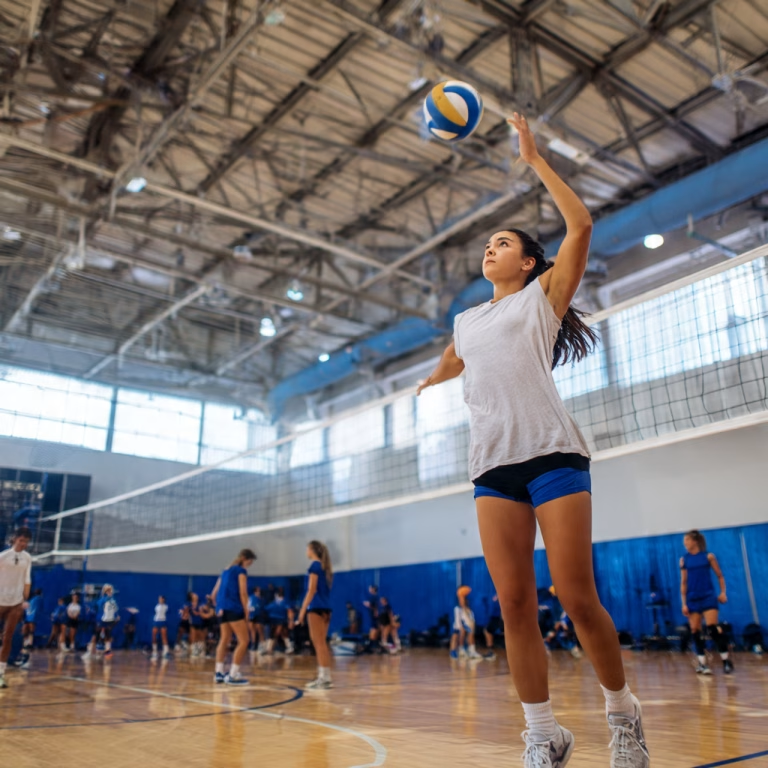Volleyball is a team game included in school physical education programs. Volleyball for kids has simple rules and offers an engaging gameplay experience. In this article, we will look at the benefits of playing volleyball, the basic rules, and the appropriate age to enroll a child in a sports section.
Volleyball for Kids: Benefits of Volleyball for Children: What Skills It Develops
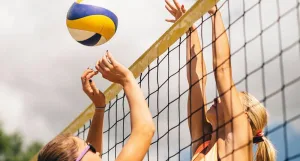
Like any team sport, volleyball greatly impacts a child’s development. Moreover, volleyball is considered one of the safest sports for kids since there is no direct contact with the opponent, no intense physical strain, and the rules are easy to understand.
Playing this sport helps develop the following qualities in children:
- Communication Skills: Through team play, children learn to interact with each other to achieve a common goal.
- Work Ethics: Young athletes begin to appreciate the value of their effort and strive to achieve the best results in everything.
- Self-Confidence: Teamwork helps build self-confidence and encourages children to present their best selves. The support of the team positively influences social adaptation, and in the future, the child will confidently pursue adult goals.
In addition, playing volleyball positively affects both the physical and intellectual development of children.
Those involved in sports tend to perform better academically and show greater endurance and a stronger immune system. In addition to the already described benefits of volleyball, its features include:
- A large number of jumping movements, which are very beneficial for a child’s health.
- The need to concentrate on the game situation.
- Constant shifts in physical and emotional intensity.
All of this positively affects a child’s developing body and helps strengthen their mental and physical health.
During play, the ball can cause injuries of varying severity. That’s why a light warm-up is recommended before starting volleyball practice. Moreover, it is crucial to choose the best volleyball shoes that prevent slipping on the court.
- Strengthening the Body
In this section, we will look at the health benefits of volleyball for kids. The usefulness of the game in this regard manifests in the following ways:
- Volleyball training primarily hardens the child’s body and increases endurance.
- It strengthens the cardiovascular system and helps improve blood circulation.
- Volleyball has a positive impact on the child’s respiratory system.
- Almost all muscle groups are engaged and trained during the game.
Important! Such activities strengthen the musculoskeletal system and improve joint mobility. Training significantly influences the development of coordination and the improvement of the vestibular system.
- Social and psychological aspects
From a psychological standpoint, volleyball not only strengthens a child’s nervous system but also improves their mood and helps fight depression. It assists both children and adults in overcoming inherent complexity. Engaging in this sport allows for complete self-expression and helps children connect with their peers.
In conclusion, volleyball, like other team sports, instills a sense of responsibility towards others. It teaches the basics of working as a team, fully trusting all its members.
For overall physical development, the type of volleyball doesn’t matter. You can enroll your child in a school volleyball section or beach volleyball, and the benefits will be significant either way.
Volleyball for Kids: Boys and Girls
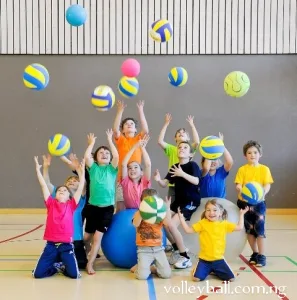
Volleyball is one of the few sports equally suitable for both boys and girls. If you are unsure whether this sport is right for your child, consider their personality. If the child enjoys playing with peers, always participates in team games, and has many friends, they will likely feel comfortable in this sport. You can also take a sports aptitude test, which can be done at home.
Professional sections accept children of both genders regardless of height since volleyball requires both tall and shorter players.
Volleyball for Kids: Basic volleyball rules for children
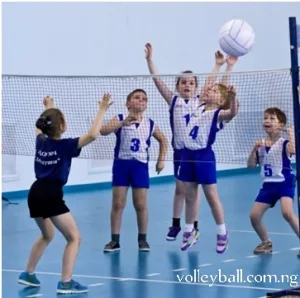
The basic rules of volleyball for kids revolve around scoring points for their team. Points are earned when the ball hits the floor on the opponent’s side or goes out of bounds. Additionally, a team can earn extra points in the following cases:
- The opponent violated the serve rules.
- The opponent failed to get the ball over the net.
- The opponent broke attack rules.
- The opponent violated ball-passing rules.
- The opponent violated rotation rules.
The team that reaches 25 points first is declared the winner, but they must have a lead of at least 2 points. If this margin isn’t met, the game continues until the condition is fulfilled.
Read More:
- Comprehensive Volleyball Rules for Kids
- Underhand Serve in Volleyball: Meaning and Step-by-Step Guide
Volleyball for Kids: At What Age to Start Volleyball—Choosing a Section
Volleyball is considered a late-start sport, meaning that children are typically accepted into sections once they reach school age. Experts recommend that the best age to start professional training is between 9 and 10 years old for both boys and girls. However, older children can also join sections, with coaches accepting kids at 13 and even 15 years old.
Before enrolling in a section, you must obtain sports insurance, which is mandatory for participating in competitions in many countries.
See Also: Minimum Height for Volleyball Player Female: Average Height for Male and Female Athletic
Potential Contraindications
Keep in mind that volleyball has some contraindications. Children with musculoskeletal disorders, asthma, gastrointestinal diseases, and cardiovascular issues may not be accepted into sections. However, in some cases, sports are not completely off limits. For example, volleyball can help children with poor posture address spinal issues.
Volleyball for kids: Exercise with volleyball elements for children
Since volleyball is safe and beneficial for children, parents are encouraged to involve younger children in volleyball-related activities. For the youngest, there are exercises with volleyball elements. Here’s a list of such exercises:
- Don’t Drop the Ball
- Don’t let them catch the ball.
- Try to Take It Away
- Ball to the Middle
- Circular Lapta
- Perestreboll
- Snipers
- Shootout
- Bombardment
- Volleyball Blindfold
All these active games have simple rules and develop basic skills needed for volleyball. These games are commonly played at summer camps or during physical education lessons at school. You can easily find the rules online and play with your child and their friends.
Volleyball Games for Kids: 10 Game-Based Exercises for Kids
One of the primary tasks of a coach when teaching volleyball to young school-age and preschool children is to create conditions where the child enjoys the training emotionally and aesthetically.
While in later stages of training this can be achieved directly through playing volleyball, at the beginner stage, this is impossible because the children do not yet possess the necessary skills for the game.
Here, the game-based learning method comes in handy. It not only allows practicing specific volleyball techniques but also keeps the training at a high emotional level. Below are 10 of the most accessible games aimed at improving volleyball passing skills for kids.
Game Names:
- Wandering Ball
- Windmill
- Ball Race in the Corridor
- Who Lasts Longer
- Who Goes Further
- Relays
Wandering Ball: Volleyball Game for Kids
- Equipment and Venue: Sports hall or open field, volleyball ball.
- Game Description: Players stand in a circle of any diameter, spaced apart at any distance. One player holds the ball. Another player (the “it”) stands inside the circle. The players perform overhead (or underhand) passes to each other in any direction. The “it” tries to touch the ball while moving inside the circle. If the “it” touches the ball, the player who made the pass touched becomes the new “it,” and the previous “it” takes that player’s place. The game is played for time, and the winner is the player who was “it” the least.
Notes: A participant may only touch the ball once. If they touch the ball twice in a row, they become the “it.”
If a player makes a mistake that leads to the ball being touched, they become the “it.”
- Methodical Instructions:
Depending on the players’ skill level and the goals of the training, restrictions may be introduced:
- Passing the ball only with an overhead pass.
- Passing the ball only with an underhand pass.
The fewer players there are, the harder it is to make passes, and the motor intensity of the game increases. Therefore, the coach may divide the group into smaller teams and organize several circles.
Windmill: Volleyball Game for Kids
- Equipment and Venue:
A volleyball attached to a cord (1.5–2.5 m), two volleyballs, volleyball court.
- Game Preparation:
The players are divided into two equal teams and line up behind the end line in a column (see diagram). The first players in each column hold a volleyball. The “it” stands on a table (or chair, gymnastics horse, etc.) in the center of the middle line. They hold a ball attached to a cord and spin it in a frontal plane. On the floor, on both sides of the “it,” four lines (two corridors, 2-3 meters wide) are drawn to be fully covered by the spinning ball.
The game continues as each team takes turns navigating the challenge.
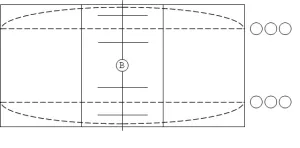
- Game Description:
At the coach’s signal, the leading players in the columns start moving forward (along the straight dotted line), performing overhead (or underhand) passes over themselves. Upon reaching the corridor, they must pass through it, staying within the lines, in such a way that the rotating ball does not touch them. Then, continuing to perform passes over themselves, the players proceed to the end line, take the ball in their hands, and run back (along the curved dotted line) where they pass the ball to the next player on their team (throwing the ball to a teammate is prohibited). The next players perform the same actions as the previous ones, and so on. The team that accumulates the fewest penalty points wins.
- A penalty point is awarded if:
a) A player is touched by the rotating ball.
b) A player drops the ball on the floor (in any case).
c) The next player in the column starts before taking the ball from the previous player.
Ball Race in the Corridor: Volleyball Game for Kids
- Equipment and Venue:
A sports hall or open field, two volleyballs.
- Game Preparation:
The players are divided into two teams with an even number of participants on each team. The players of each team line up in two rows facing each other at a distance of 4 meters or more. The teams are 4–8 steps apart. The first player of each team holds a volleyball.
- Game Description:
At the coach’s signal, the players holding the ball perform an overhead (or underhand) pass to the player standing opposite. That player passes it the same way to the next player standing next to the first. When the ball reaches the last player on the team, the whole process is repeated in reverse. As soon as the ball returns to the first player, they raise the ball up and shout “Done!” signaling that their team has finished the game. The team that finishes passing first wins.
The game can also be played for time (or for a set number of rounds); in this case, the ball will be passed “back and forth” several times.
- Notes:
The ball can only be passed using the method specified by the coach.
Passing the ball over one or more players is prohibited.
Who Lasts Longer: Volleyball Game for Kids
This game is recommended not only for beginner volleyball players but also for those with some experience.
- Venue and Equipment:
Two volleyballs, volleyball or open field.
- Game Preparation:
Players are divided into two equal teams, which line up behind the end line in a column one behind the other. The columns are 5–9 meters apart. At a distance of 4-9 meters (depending on the players’ skills), a circle with a diameter of 3-5 meters is drawn in front of each column. The first players in the column take volleyballs and stand in the center of the circle.
- Game Description:
At the coach’s signal, the players standing in the center of the circle perform a pass (or several passes) over themselves, trying to make the pass (or the last pass) as high as possible while ensuring that the ball stays within the circle. After making the pass (or the last pass), these players run to the end of the column. Before the ball touches the ground, the next player in the column runs into the circle and performs a pass (or several passes) over themselves, and so on.
- Rules:
During the game, it is prohibited to:
- Let the ball fall to the ground.
- Make passes outside the circle.
- Cross the end line before the teammate in the circle performs a pass over themselves.
The winner can be determined in two ways:
- The team that breaks the rules first loses.
- The team that accumulates fewer penalty points wins (each rule violation earns a penalty point).
- Methodical Note:
It’s important to ensure that after quick movements, players make passes in the circle from the volleyball-ready stance.
Who Goes Further: Volleyball Game for Kids
- Equipment and Venue:
Volleyballs, gym or open field.
- Game Description:
The game involves two equal teams that line up in two rows facing each other at a distance of 5–10 meters. Each player on one team holds a volleyball. At the coach’s signal, they throw the ball over themselves and send it towards the opposing player using an overhead pass, trying to send the ball as far as possible. Once the ball touches the ground, the corresponding player on the opposing team catches the ball and, from where it landed, performs a pass back to the opposing player, and so on. The game continues until the opposing players have pushed each other behind a predetermined line (drawn on the floor). The team that pushes more players past the line wins.
- Rules of the Game:
Players perform passes in pairs. Switching partners is prohibited.
The pass must be executed in the specified manner, following the technique (underhand, overhead, backward-facing, forward-facing, etc.).
The ball cannot be caught until it touches the ground.
This game can also be used as a means of physical training for beginner volleyball players. Instead of volleyballs, weighted balls can be used, and instead of passes, throws can be performed, strictly according to the coach’s instructions. However, it should be noted that games with weighted balls should only be played when the gym size and the number of participants allow pairs to stay at a safe distance from each other (five meters or more), minimizing the risk of accidental head injury. In such cases, the coach should be especially vigilant.
Relays in Volleyball Game for Kids
The players are lined up in two columns facing the wall. At the coach’s signal, the first players in the column perform an overhead pass against the wall and then move to the end of the column.
There are various ways to determine the winner:
a) The team that goes the longest without dropping the ball wins.
b) The team that performs the most passes within a set time wins (if the ball is dropped, the player must pick it up, return to the column, and perform the pass again).
c) The team that performs the fewest passes in a set time wins (if the ball is dropped, the player must pick it up, return to the column, and perform the pass again).
At a distance of 2-4 meters from the wall, three to four teams stand in columns facing the wall. At the coach’s signal, the first players in the column perform 3-5 passes against the wall and then move to the end of the column. The next player performs the pass before the ball touches the ground, and so on. The winner is determined as in the previous relay. In options b) and c), if the ball is dropped, the player must pick it up, return to the column, and perform 3-5 passes again.
The starting position of the players is by the wall, in two columns. At the coach’s signal, the first players in the column perform a pass over themselves and then pass the ball against the wall and move to the end of the column. The next player enters the game and so on. The winner is determined similarly to the previous relays. In options b) and c), if the ball is dropped, the player must pick it up, return to the column, and perform the pass again.
Each team is divided into two groups and lined up in two facing columns, 3-6 meters apart. The distance between teams is 4-6 meters. At the signal, the teams begin performing passes to each other. After performing a pass, the player moves either:
a) to the end of their own column,
b) to the end of the opposite column.
The determination of the winner and the actions of players who make mistakes are similar to the previous relays.
This relay can also be conducted by having players first perform a pass over themselves and then to the opposite column. Additionally, the relay can be conducted across a net.
In the relay, 2-3 teams line up in single file in front of the net (the distance to the net can be adjusted). The distance between the columns is 3-4 meters. A mat is placed on the opposite side of the court in front of each team. At the coach’s signal, the leading players in the columns, using an overhead pass, try to hit the mat. After the pass, the players run under the net, retrieve the ball, and pass it to the next player in their column. The team that hits the mat the most times wins.
Using the games and exercises presented in this article for volleyball training requires a creative approach from the coach, who can modify the content and conditions of the exercises depending on the goals of the training session and the level of the players. For example, if players are not sufficiently prepared, in the first relay, the pass to the wall can be performed after the ball bounces off the floor.
I’d also like to note that almost all the presented exercises can be used to improve both overhead and underhand passes. Additionally, all these exercises, conducted at a high emotional level, help develop children’s attention, peripheral vision, and a sense of teamwork, which are essential in volleyball.
See Also: 10 Best Kids Volleyball Shoes
You can rate the article on a five-point scale. Thank you!

